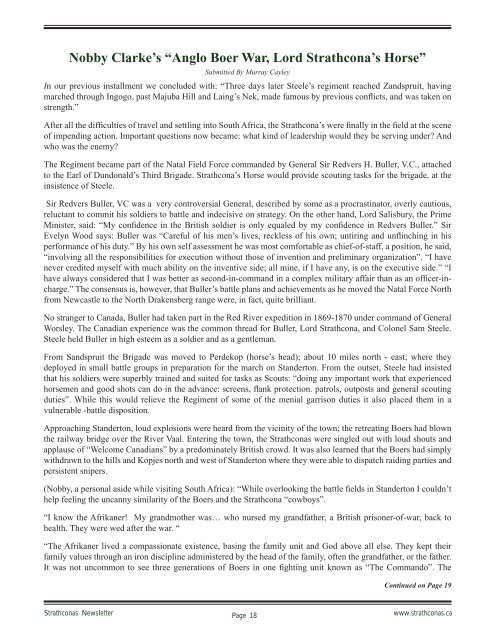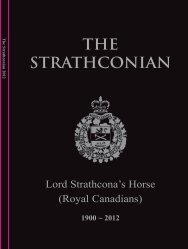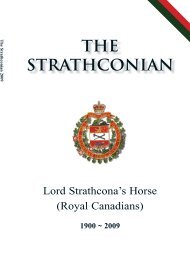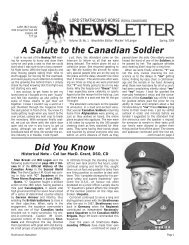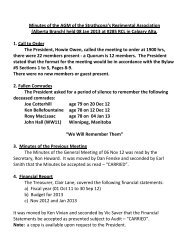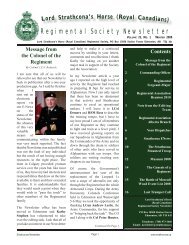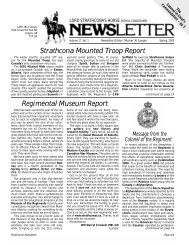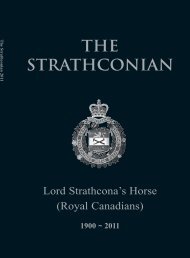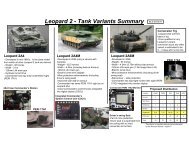Regimental Society Newsletter S s - Lord Strathcona's Horse
Regimental Society Newsletter S s - Lord Strathcona's Horse
Regimental Society Newsletter S s - Lord Strathcona's Horse
Create successful ePaper yourself
Turn your PDF publications into a flip-book with our unique Google optimized e-Paper software.
Nobby Clarke’s “Anglo Boer War, <strong>Lord</strong> Strathcona’s <strong>Horse</strong>”Submitted By Murray CayleyIn our previous installment we concluded with: “Three days later Steele’s regiment reached Zandspruit, havingmarched through Ingogo, past Majuba Hill and Laing’s Nek, made famous by previous conflicts, and was taken onstrength.”After all the difficulties of travel and settling into South Africa, the Strathcona’s were finally in the field at the sceneof impending action. Important questions now became: what kind of leadership would they be serving under? Andwho was the enemy?The Regiment became part of the Natal Field Force commanded by General Sir Redvers H. Buller, V.C., attachedto the Earl of Dundonald’s Third Brigade. Strathcona’s <strong>Horse</strong> would provide scouting tasks for the brigade, at theinsistence of Steele.Sir Redvers Buller, VC was a very controversial General, described by some as a procrastinator, overly cautious,reluctant to commit his soldiers to battle and indecisive on strategy. On the other hand, <strong>Lord</strong> Salisbury, the PrimeMinister, said: “My confidence in the British soldier is only equaled by my confidence in Redvers Buller.” SirEvelyn Wood says: Buller was “Careful of his men’s lives, reckless of his own; untiring and unflinching in hisperformance of his duty.” By his own self assessment he was most comfortable as chief-of-staff, a position, he said,“involving all the responsibilities for execution without those of invention and preliminary organization”. “I havenever credited myself with much ability on the inventive side; all mine, if I have any, is on the executive side.” “Ihave always considered that I was better as second-in-command in a complex military affair than as an officer-incharge.”The consensus is, however, that Buller’s battle plans and achievements as he moved the Natal Force Northfrom Newcastle to the North Drakensberg range were, in fact, quite brilliant.No stranger to Canada, Buller had taken part in the Red River expedition in 1869-1870 under command of GeneralWorsley. The Canadian experience was the common thread for Buller, <strong>Lord</strong> Strathcona, and Colonel Sam Steele.Steele held Buller in high esteem as a soldier and as a gentleman.From Sandspruit the Brigade was moved to Perdekop (horse’s head); about 10 miles north - east; where theydeployed in small battle groups in preparation for the march on Standerton. From the outset, Steele had insistedthat his soldiers were superbly trained and suited for tasks as Scouts: “doing any important work that experiencedhorsemen and good shots can do in the advance: screens, flank protection. patrols, outposts and general scoutingduties”. While this would relieve the Regiment of some of the menial garrison duties it also placed them in avulnerable -battle disposition.Approaching Standerton, loud explosions were heard from the vicinity of the town; the retreating Boers had blownthe railway bridge over the River Vaal. Entering the town, the Strathconas were singled out with loud shouts andapplause of “Welcome Canadians” by a predominately British crowd. It was also learned that the Boers had simplywithdrawn to the hills and Kopjes north and west of Standerton where they were able to dispatch raiding parties andpersistent snipers.(Nobby, a personal aside while visiting South Africa): “While overlooking the battle fields in Standerton I couldn’thelp feeling the uncanny similarity of the Boers and the Strathcona “cowboys”.“I know the Afrikaner! My grandmother was… who nursed my grandfather, a British prisoner-of-war, back tohealth. They were wed after the war. ““The Afrikaner lived a compassionate existence, basing the family unit and God above all else. They kept theirfamily values through an iron discipline administered by the head of the family, often the grandfather, or the father.It was not uncommon to see three generations of Boers in one fighting unit known as “The Commando”. TheContinued on Page 19Strathconas <strong>Newsletter</strong>Page 18www.strathconas.ca


